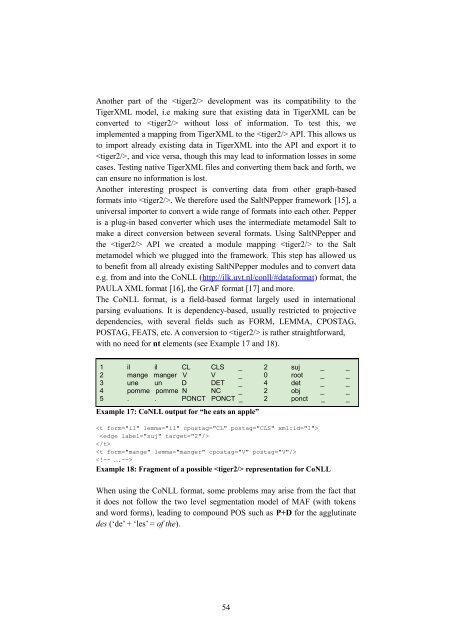A Treebank-based Investigation of IPP-triggering Verbs in Dutch
A Treebank-based Investigation of IPP-triggering Verbs in Dutch
A Treebank-based Investigation of IPP-triggering Verbs in Dutch
You also want an ePaper? Increase the reach of your titles
YUMPU automatically turns print PDFs into web optimized ePapers that Google loves.
Another part <strong>of</strong> the development was its compatibility to the<br />
TigerXML model, i.e mak<strong>in</strong>g sure that exist<strong>in</strong>g data <strong>in</strong> TigerXML can be<br />
converted to without loss <strong>of</strong> <strong>in</strong>formation. To test this, we<br />
implemented a mapp<strong>in</strong>g from TigerXML to the API. This allows us<br />
to import already exist<strong>in</strong>g data <strong>in</strong> TigerXML <strong>in</strong>to the API and export it to<br />
, and vice versa, though this may lead to <strong>in</strong>formation losses <strong>in</strong> some<br />
cases. Test<strong>in</strong>g native TigerXML files and convert<strong>in</strong>g them back and forth, we<br />
can ensure no <strong>in</strong>formation is lost.<br />
Another <strong>in</strong>terest<strong>in</strong>g prospect is convert<strong>in</strong>g data from other graph-<strong>based</strong><br />
formats <strong>in</strong>to . We therefore used the SaltNPepper framework [15], a<br />
universal importer to convert a wide range <strong>of</strong> formats <strong>in</strong>to each other. Pepper<br />
is a plug-<strong>in</strong> <strong>based</strong> converter which uses the <strong>in</strong>termediate metamodel Salt to<br />
make a direct conversion between several formats. Us<strong>in</strong>g SaltNPepper and<br />
the API we created a module mapp<strong>in</strong>g to the Salt<br />
metamodel which we plugged <strong>in</strong>to the framework. This step has allowed us<br />
to benefit from all already exist<strong>in</strong>g SaltNPepper modules and to convert data<br />
e.g. from and <strong>in</strong>to the CoNLL (http://ilk.uvt.nl/conll/#dataforma t) format, the<br />
PAULA XML format [16], the GrAF format [17] and more.<br />
The CoNLL format, is a field-<strong>based</strong> format largely used <strong>in</strong> <strong>in</strong>ternational<br />
pars<strong>in</strong>g evaluations. It is dependency-<strong>based</strong>, usually restricted to projective<br />
dependencies, with several fields such as FORM, LEMMA, CPOSTAG,<br />
POSTAG, FEATS, etc. A conversion to is rather straightforward,<br />
with no need for nt elements (see Example 17 and 18).<br />
1 il il CL CLS _ 2 suj _ _<br />
2 mange manger V V _ 0 root _ _<br />
3 une un D DET _ 4 det _ _<br />
4 pomme pomme N NC _ 2 obj _ _<br />
5 . . PONCT PONCT _ 2 ponct _ _<br />
Example 17: CoNLL output for “he eats an apple”<br />
<br />
<br />
<br />
<br />
<br />
Example 18: Fragment <strong>of</strong> a possible representation for CoNLL<br />
When us<strong>in</strong>g the CoNLL format, some problems may arise from the fact that<br />
it does not follow the two level segmentation model <strong>of</strong> MAF (with tokens<br />
and word forms), lead<strong>in</strong>g to compound POS such as P+D for the agglut<strong>in</strong>ate<br />
des (‘de’ + ‘les’ = <strong>of</strong> the).<br />
54
















